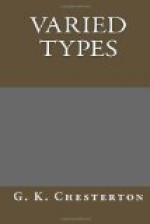All old and vigorous languages abound in images and metaphors, which, though lightly and casually used, are in truth poems in themselves, and poems of a high and striking order. Perhaps no phrase is so terribly significant as the phrase “killing time.” It is a tremendous and poetical image, the image of a kind of cosmic parricide. There are on the earth a race of revellers who do, under all their exuberance, fundamentally regard time as an enemy. Of these were Charles II. and the men of the Restoration. Whatever may have been their merits, and as we have said we think that they had merits, they can never have a place among the great representatives of the joy of life, for they belonged to those lower epicureans who kill time, as opposed to those higher epicureans who make time live.
Of a people in this temper Charles II. was the natural and rightful head. He may have been a pantomime King, but he was a King, and with all his geniality he let nobody forget it. He was not, indeed, the aimless flaneur that he has been represented. He was a patient and cunning politician, who disguised his wisdom under so perfect a mask of folly that he not only deceived his allies and opponents, but has deceived almost all the historians that have come after him. But if Charles was, as he emphatically was, the only Stuart who really achieved despotism, it was greatly due to the temper of the nation and the age. Despotism is the easiest of all governments, at any rate for the governed.
It is indeed a form of slavery, and it is the despot who is the slave. Men in a state of decadence employ professionals to fight for them, professionals to dance for them, and a professional to rule them.




